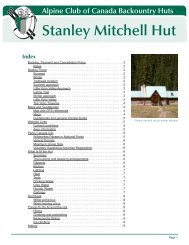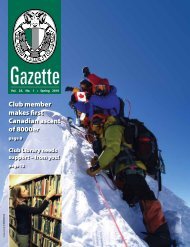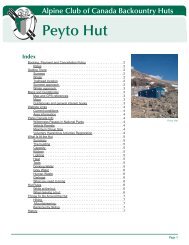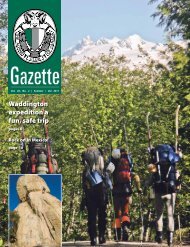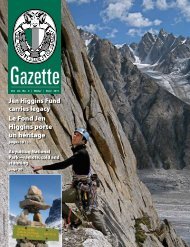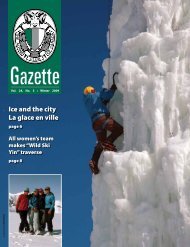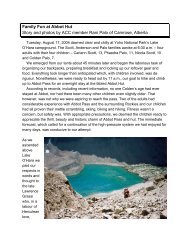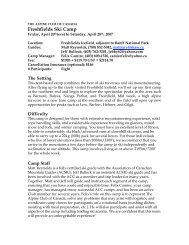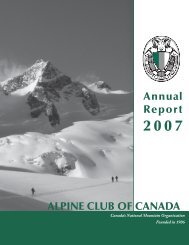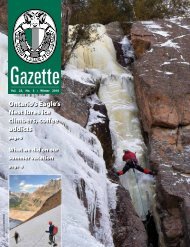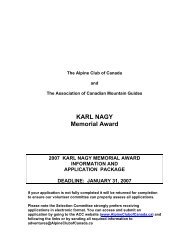Fall 2006 - The Alpine Club of Canada
Fall 2006 - The Alpine Club of Canada
Fall 2006 - The Alpine Club of Canada
Create successful ePaper yourself
Turn your PDF publications into a flip-book with our unique Google optimized e-Paper software.
Researchers study Juneau Icefi eld<br />
BY PABLO WAINSTEIN<br />
Wind started to blow and I<br />
felt the chills on my back.<br />
My partners and I had been<br />
working all day on Taku Glacier on<br />
Alaska’s Juneau Icefi eld, digging snow<br />
pits and setting up ablation stakes to<br />
measure the losses and gains <strong>of</strong> snow<br />
and ice <strong>of</strong> the icefi eld. Known as a mass<br />
balance, the process requires digging<br />
several snow pits four or fi ve metres<br />
deep to see how much snow is left from<br />
the previous year’s snowfall. After the<br />
fi rst layer from the previous winter is<br />
determined, its depth is measured and<br />
snow samples are taken from the pit wall<br />
to calculate the snow’s density and water<br />
equivalency. Covering about 671 square<br />
kilometres, with a maximum depth <strong>of</strong><br />
about 1400 m, Taku Glacier is considered<br />
a maritime temperate glacier because it<br />
is located near the ocean coastline and its<br />
ice is on average 0°C from the surface to<br />
the bottom.<br />
As a member <strong>of</strong> the Juneau Icefi eld<br />
Research Program ( JIRP), I am part <strong>of</strong><br />
a research team that works in a huge<br />
and awesome outdoor lab. Watching<br />
water carve its way through ice, building<br />
a piping system that looks almost as<br />
Pablo Wainstein conducts ground penetrating<br />
radar surveys to determine the glacier’s depth and<br />
inner hydrology. SUBMITTED PHOTO<br />
complicated a Swiss cheese, I have<br />
worked on several glaciers in Alaska,<br />
Alberta, British Columbia, the Andes<br />
and Patagonia. In all those places, glaciers<br />
share a common denominator – they are<br />
retreating.<br />
� � �<br />
In 1946, a young PhD student named<br />
Maynard M. Miller, full <strong>of</strong> energy and<br />
a keen interest in understanding the<br />
frozen world around us, decided to<br />
begin research on the Juneau Icefi eld,<br />
which stretches from Juneau, Alaska to<br />
the southern limits <strong>of</strong> Atlin Lake BC.<br />
He formed a group <strong>of</strong> researchers and<br />
mountaineers in order to explore and<br />
trace access routes onto Taku Glacier.<br />
After struggling through the Alaskan<br />
bush they were astonished with what<br />
they saw – an enormous natural lab to<br />
study glaciers. Th e expedition was very<br />
successful, triggering the formation <strong>of</strong><br />
the JIRP, one <strong>of</strong> the world’s longest<br />
research and educational programs in<br />
glaciology. With slightly more than 60<br />
years <strong>of</strong> operation, thousands <strong>of</strong> students<br />
haven gone through the program, and<br />
many prosperous research careers have<br />
developed.<br />
Based in Juneau, every year the<br />
program receives students from <strong>Canada</strong>,<br />
the U.S. and other parts <strong>of</strong> the world<br />
interested in learning about natural<br />
systems, glaciology and climatology, and<br />
more importantly to gain experience in<br />
fi eldwork. After spending some days in<br />
Juneau, traveling around the Mendenhall<br />
and Herbert Glaciers, students, staff<br />
and researchers begin their long journey<br />
that for years has been done by foot<br />
and ski across the icefi eld. Supplies and<br />
equipment are fl own in by helicopter.<br />
Along the route, JIRP has established<br />
several research stations that enable<br />
safe and eff ective fi eldwork. Alaska can<br />
sometimes present such hostile weather<br />
that research is hindered by the needs<br />
<strong>of</strong> survival during the eight weeks <strong>of</strong> the<br />
program.<br />
Years ago, much more time was<br />
dedicated to normal daily routines.<br />
Nowadays, thanks to the facilities and<br />
organization, researchers can dedicate<br />
more eff ective time to their teaching and<br />
fi eld experiences. Th e group stays two<br />
weeks per station. As the team moves<br />
forward into the icefi eld toward the town<br />
<strong>of</strong> Atlin BC, the weather becomes drier<br />
and more comfortable. Near the icefi eld’s<br />
northern limits, where the landscape<br />
has been transformed by retreating<br />
glaciers, nights are sometimes coloured<br />
by vibrant northern lights. Countless<br />
diff erent geomorphologic features such<br />
as moraines, lakes and rivers have evolved<br />
due to the warming period the earth is<br />
suff ering.<br />
As glaciers advanced during colder<br />
climate periods <strong>of</strong> past geological history,<br />
ice eroded the valley bottoms and<br />
sides, scraping out material that then<br />
accumulated at the front or margins<br />
<strong>of</strong> the glacier. Later, during periods<br />
<strong>of</strong> warmer climate, ice bodies began<br />
retreating, leaving behind elongated<br />
accumulations <strong>of</strong> debris – moraines –<br />
which sometimes act as natural dams that<br />
incite the collection <strong>of</strong> meltwater forming<br />
a pro glacial lake. Th ese are common in<br />
the Canadian Rockies.<br />
Th rough JIRP’s 60 years <strong>of</strong> research,<br />
glaciers have been retreating drastically.<br />
Camp 10, one <strong>of</strong> JIRP’s largest stations on the Juneau Icefi eld, accommodating up to 50 people, has been<br />
the main camp for the research program’s operations throughout its history. PHOTO BY PABLO WAINSTEIN



